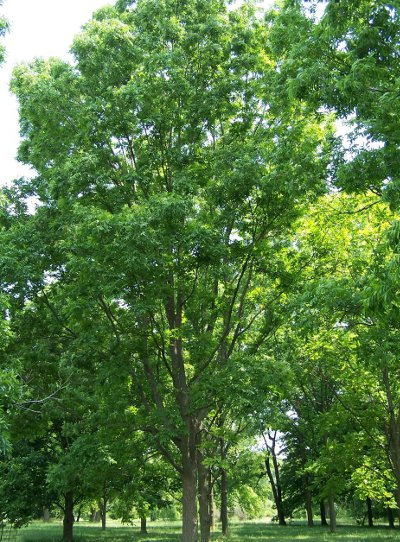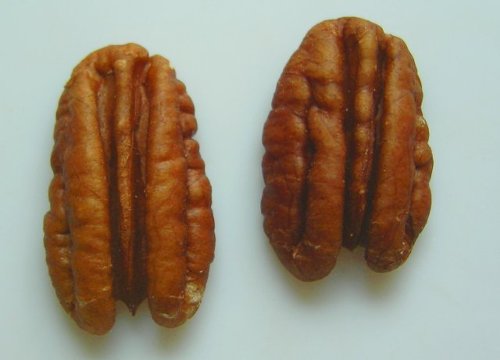Pecan
 Common name: Pecan. Pecan comes from the native american language Algonquian which means hard shell.
Common name: Pecan. Pecan comes from the native american language Algonquian which means hard shell.
Scientific name: Carya illinoinensis
Climate: Temperate
Plant description: It is a very beautiful, deciduous tree of the Yuglandáceas family. It grows from 25 to 50 m tall. Its magnificent glass covers up to 20 meters and its trunk reaches 2 meters in diameter.
Its bark is light gray or brown and covered with scales or lamellar peels. The leaves are composed of oval and serrated leaflets that are 40-70 cm long. The flowers are greenish and look like spikes or clusters that measure about 20 cm.
Its edible fruit is a drupe, it has a resemblance to walnut, its shell is smooth, soft, dark brown in color and ovoid in shape, the almond it houses is rough, round, hard and light brown. Its flavor is more subtle than walnut. It is also more oily.
The pecan is native to the southern United States and northern Mexico
Cultivation: It reproduces by seeds, which should preferably be sown on site, during the winter. They germinate in spring
It grows in places with long, hot and humid summers. It needs deep, moist, well-drained soil rich in organic matter.
With good humidity, sun and nutrients, the tree can grow about 90 centimeters each year. It generally begins to bear fruit at the age of 20, although it is said that the stages of greatest production occur after the age of 75. When it matures, it can supply about 40 kilos of pecans every 12 months.
Two or more trees of different cultivars must be present to pollinate each other
The harvest takes place in mid-October. It can bear fruit for over three hundred years.
 Uses: Native American Kiowa used a decoction of the bark as a remedy against tuberculosis, and the Comanches used the powder of dried leaves in friction against ringworm.
Uses: Native American Kiowa used a decoction of the bark as a remedy against tuberculosis, and the Comanches used the powder of dried leaves in friction against ringworm.
The bark and leaves are astringent. In Mexico, the bark is used to cure intermittent fevers and dyspepsia. It helps strengthen the immune system and reduces blood pressure.
Pecan contains 9.17 grams of protein per 100 grams, providing 2800 kJ of energy. In addition, a 28 gram serving of pecans has 25% more oleic acid than the amount you get from a tablespoonful of olive oil. Pecans are also very rich in minerals like potassium and zinc, which are great for your neural system.
To all these benefits is added its contribution of vitamins, nutrients and antioxidants, which help maintain overall and general health.
Pecan can be eaten fresh or cooked, especially in pastry. It is used in fillings, nut breads, ice cream, and salty vegetable dishes.
Pecans wood is red, dark, heavy, hard but elastic, it is used to make agricultural tools, furniture, skis, bows and golf clubs.
Pests and diseases: Pecans are prone to infection by bacteria and fungi such as Pecan scab, especially in humid conditions. Scab is currently the most destructive disease affecting pecan trees untreated with fungicides.
Various insects feed on the leaves stems and developing nuts. These include ambrosia beetles, twig girdlers, pecan nut casebearer, hickory shuckworm, phylloxera, curculio, weevils, and several aphid species.
References:
Beneficios e Información de Pacana. (s. f.). Herbwisdom. Recuperado 30 de julio de 2020, de https://www.herbwisdom.com/es/herb-pecans.html
Boletin agrario. (s. f.). Pacana. Recuperado 30 de julio de 2020, de https://boletinagrario.com/ap-6,pacana,158.html
colaboradores de Wikipedia. (2020, 22 julio). Carya illinoinensis. Wikipedia, la enciclopedia libre. https://es.wikipedia.org/wiki/Carya_illinoinensis
(2017, 10 marzo). Pacana. Flores. https://www.flores.ninja/pacana/
Wikipedia contributors. (2020, 8 julio). Pecan. Wikipedia. https://en.wikipedia.org/wiki/Pecan
En español: Pacana
